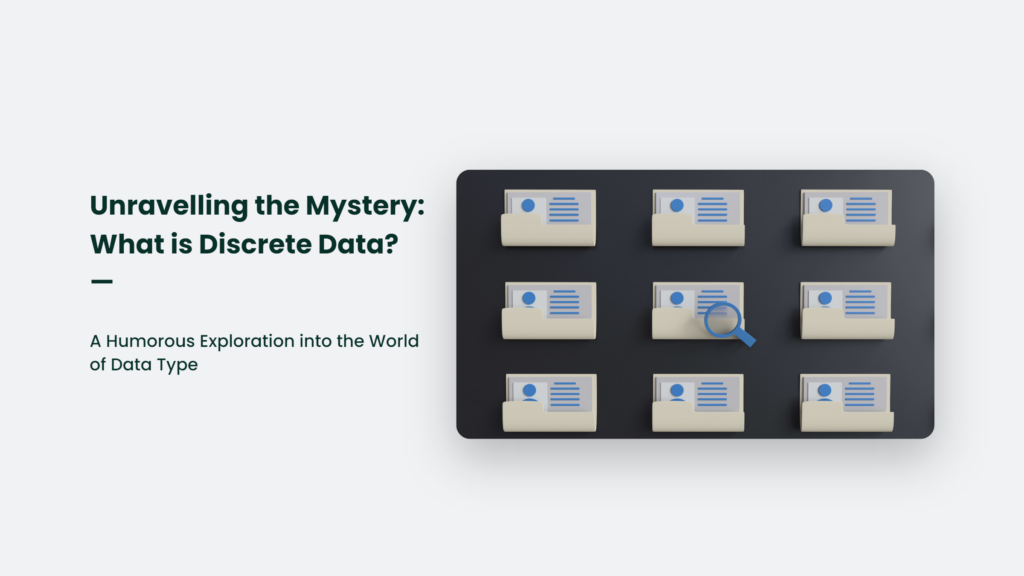
You’ve probably stumbled upon this page after battling the monstrous hydra of search results Google conjured up when you asked, “What is discrete data?” Worry not, my data-curious friend; this is your sanctuary where we break down the barricades of jargon with a sledgehammer of simplicity, a pinch of humour, and plenty of anecdotes and insights.
What is Discrete Data?
Picture this: You’re in the supermarket, a fluorescent-lit cathedral of consumerism, clutching a shopping list in one hand and a basket that grows heavier with every passing aisle in the other. Now, how many cartons of milk can you buy? Or how many bags of chips or cans of soda? The answer, my friends, is always a whole number. You can’t buy 2.67 bags of chips, can you?
This, my friends, is a simple, real-life example of discrete data — data that can only take particular, separate values. You can’t have 0.5 of a kid or 3.3 dogs (unless you’re into some really weird taxidermy). Each of these is a discrete data point: absolute, indivisible units. They’re the steadfast squares on a checkered board, unwilling to compromise their edges for anyone or anything.
The Power of Discrete Data in Computing
In the grand realm of computing, discrete data wears the crown. Binary code, the language of computers, is a perfect example of discrete data. It’s all 1s and 0s, no room for fractional confusion here.
Remember the old SQL vs. NoSQL debate for all the Computer Science enthusiasts reading? The distinction between structured (discrete) and unstructured (continuous) data was at the heart of that classic duel.
Discrete Data vs. Continuous Data: The Sibling Rivalry
Understanding data types is a bit like understanding sibling relationship dynamics. Discrete data has a sibling named continuous data. They’re related, yet so fundamentally different, like Arnold Schwarzenegger and Danny DeVito in Twins.
While discrete data is all about exact, indivisible numbers, continuous data is the free spirit of the family. It believes in all the values between integers — every decimal, every fraction — it’s all fair game. Think about measuring the length of a string, the weight of a bag of flour, or the time it takes to run a mile. These measurements can be so precisely fine-tuned that they can take any value within a range. That’s continuous data for you, always eager to blur the lines.
Diving Deeper: Categories of Discrete Data
As we delve deeper into the rabbit hole, it’s time we talk about the categories within discrete data itself.
- Nominal Data: Think of your favourite pizza toppings. They are categories, right? Well, that’s nominal data for you — data that is grouped into non-numerical categories that can’t be ranked or ordered. You can’t say that pepperoni is ‘greater’ than mushrooms, can you?
- Ordinal Data: Imagine ranking those pizza toppings according to your preference. That’s ordinal data. It’s a kind of discrete data that can be categorized and ranked.
- Binary Data: Remember the computer language we talked about? It’s either a 1 or a 0, a yes or a no. The world of binary data is black and white, with no room for greys.
Each category, with its distinct flavour, adds to the spice of discrete data, making it a versatile information beast.
The ‘Discrete’ Impact of Discrete Data
“Information is power,” Francis Bacon once stated. But let’s tweak that a little. In today’s world, ‘Relevant information is power.’ And how do we get to this relevance? Through the meticulous collection and analysis of discrete data.
Consider this: According to a report by SocialMediaToday, 73% of marketers believe social media marketing has been ‘somewhat effective’ or ‘very effective’ for their business. This statement results from analyzing discrete data points obtained from a survey — a fine testament to the power of discrete data.
Frequently Asked Questions:
How is discrete data used in real life?
Discrete data is used in various ways in real life. Marketers use it to measure the success of campaigns. Pollsters use it to predict election results. Even your fitness tracker uses it to count the steps you’ve taken in a day!
What is the main difference between discrete and continuous data?
Discrete data can only take certain values (like whole numbers), while continuous data can take any value within a range.
Your Turn: Embracing the Discreteness of Life
So, are you ready to embrace the concept of discrete data? Ready to see the world in a series of distinct, separate values? Are you prepared to count the steps you take, the breaths you breathe, and the words you speak and recognize them all as discrete data points? The choice is yours, my friend. Just remember, it’s pretty cool to be distinct in a world obsessed with blurring boundaries.




